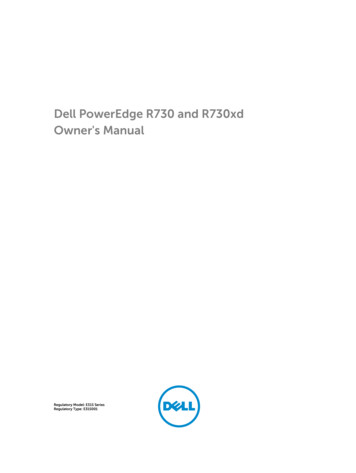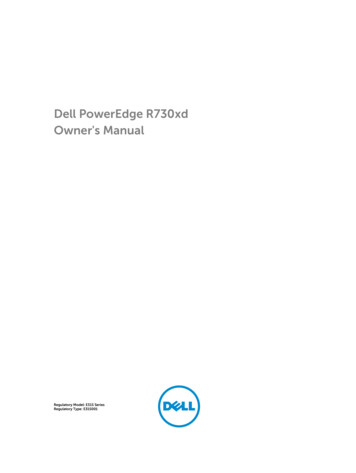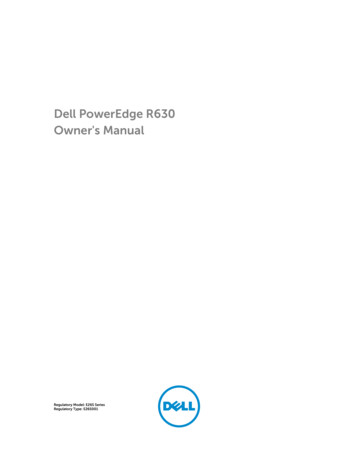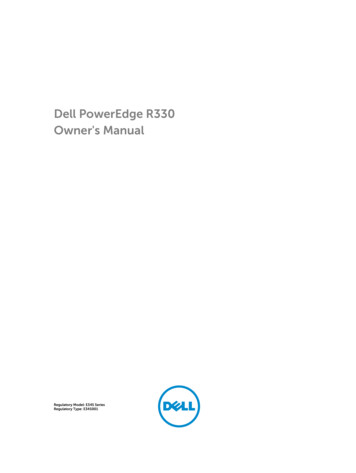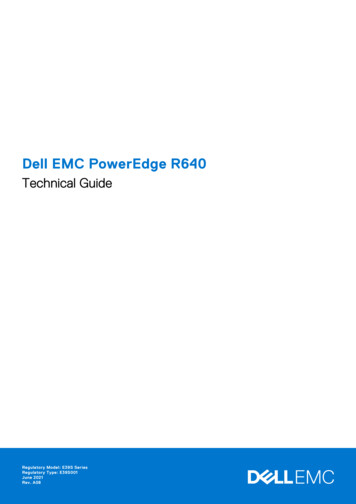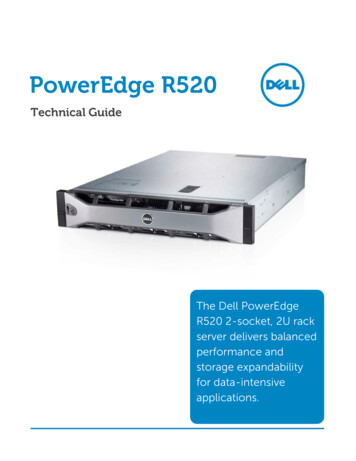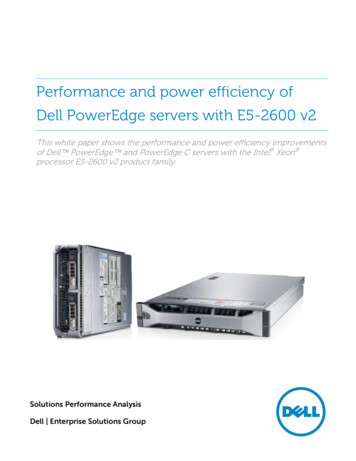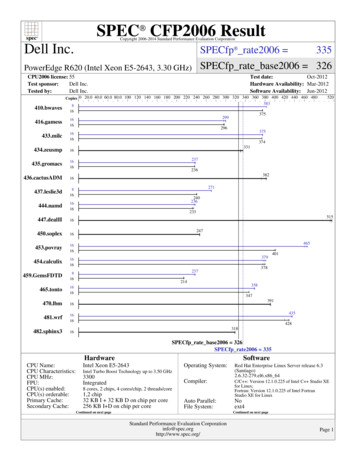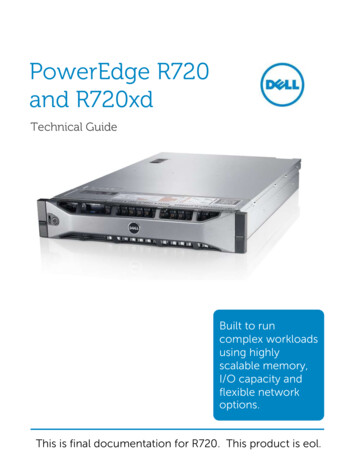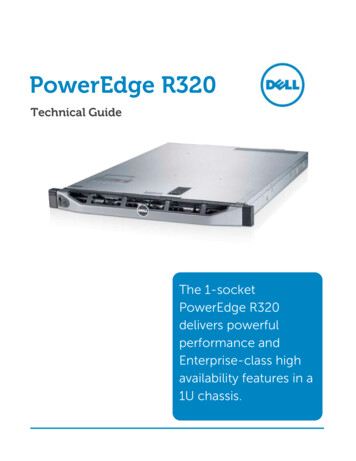
Transcription
Dell PowerEdge R730Owner's ManualRegulatory Model: E31S SeriesRegulatory Type: E31S001
Notes, cautions, and warningsNOTE: A NOTE indicates important information that helps you make better use of your computer.CAUTION: A CAUTION indicates either potential damage to hardware or loss of data and tells youhow to avoid the problem.WARNING: A WARNING indicates a potential for property damage, personal injury, or death. 2016 Dell Inc. All rights reserved. This product is protected by U.S. and international copyright and intellectualproperty laws. Dell and the Dell logo are trademarks of Dell Inc. in the United States and/or other jurisdictions. All othermarks and names mentioned herein may be trademarks of their respective companies.2016 - 05Rev. A03
Contents1 Dell PowerEdge R730 system overview.9Supported configurations for the PowerEdge R730 system. 9Front panel.103.5 inch hard drive chassis. 112.5 inch hard drive chassis.13LCD panel.15Back panel.18Diagnostic Indicators.19Diagnostic indicators.19Hard drive indicator codes. 21uSATA SSD indicator codes.22NIC indicator codes. 23Power supply unit indicator codes. 23iDRAC Direct LED indicator codes. 26Quick Sync indicator codes. 28Locating Service Tag of your system. 282 Documentation resources. 303 Technical specifications. 33Chassis dimensions. 33Chassis weight.34Processor specifications. 34PSU specifications.34System battery specifications. 34Expansion bus specifications.34Memory specifications. 35Drive specifications. 35Hard drives.35Optical drive. 36Ports and connectors specifications. 36USB ports. 36NIC ports.36Serial connector. 36VGA ports.36Internal Dual SD Module. 37Video specifications. 37Environmental specifications.373
Particulate and gaseous contamination specifications . 38Standard operating temperature. 39Expanded operating temperature.39Expanded operating temperature restrictions.404 Initial system setup and configuration. 41Setting up your system.41iDRAC configuration.41Options to set up iDRAC IP address. 41Options to install the operating system. 42Methods to download firmware and drivers.425 Pre-operating system management applications.44Options to manage the pre-operating system applications. 44System Setup.44Viewing System Setup.45System Setup details. 45System BIOS. 45iDRAC Settings utility. 68Device Settings.69Dell Lifecycle Controller. 69Embedded system management.70Boot Manager.70Viewing Boot Manager.70Boot Manager main menu. 70PXE boot.716 Installing and removing system components. 72Safety instructions. 72Before working inside your system. 72After working inside your system.73Recommended tools.73Front bezel (optional). 73Removing the optional front bezel.73Installing the optional front bezel.75System cover. 77Removing the system cover.77Installing the system cover. 78Inside the system.79Cooling shroud. 80Removing the cooling shroud. 81Installing the cooling shroud. 824
Cooling fans. 82Removing a cooling fan. 83Installing a cooling fan.84Cooling fan assembly.85Removing the cooling fan assembly. 85Installing the cooling fan assembly. 87System memory. 88General memory module installation guidelines.90Mode-specific guidelines. 90Sample memory configurations. 92Removing memory modules. 95Installing memory modules. 96Processors and heat sinks. 98Removing a heat sink. 99Removing a processor. 100Installing a processor. 104Installing a heat sink. 105PCIe card holder. 108Removing the PCIe card holder. 108Installing the PCIe card holder. 109Opening and closing the PCIe card holder latch.110Cable retention bracket. 111Removing the cable retention bracket.111Installing the cable retention bracket. 112Integrated storage controller card.113Removing the integrated storage controller card. 113Installing the integrated storage controller card. 115Expansion cards and expansion card riser.117Expansion card installation guidelines. 117Removing an expansion card from expansion card riser 2 or 3. 118Installing an expansion card into the expansion card riser 2 or 3.120Removing an expansion card from the expansion card riser 1.121Installing an expansion card into the expansion card riser 1.123Removing the riser 1 blank.124Installing the riser 1 blank.126Removing expansion card risers. 127Installing expansion card risers. 132GPU card installation guidelines. 135Removing the GPU card.136Installing a GPU card. 137Internal dual SD module (optional). 139Removing an internal SD card. 1395
Installing an internal SD card. 139Removing the optional internal dual SD module. 140Installing the optional internal dual SD module .142Network daughter card.144Removing the network daughter card . 144Installing the network daughter card. 146Internal USB memory key (optional). 148Replacing the optional internal USB memory key. 148System battery.149Replacing the system battery. 149Power supply units.151Hot spare feature. 151Removing the power supply unit blank. 151Installing the power supply unit blank.152Removing an AC power supply unit. 153Installing an AC power supply unit. 154Wiring instructions for a DC power supply unit. 155Removing a DC power supply unit.159Installing a DC power supply unit.160System board. 161Removing the system board. 161Installing the system board.164Trusted Platform Module. 167Installing the Trusted Platform Module.168Initializing the TPM for BitLocker users. 169Initializing the TPM for TXT users.
Dell PowerEdge R730 system overview The Dell PowerEdge R730 systems are rack servers that support up to two Intel Xeon E5-2600 v3 or Xeon E5-2600 v4 processors, up to 24 DIMMs, and 16 hard drives or solid state drives (SSDs).
